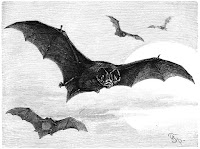 |
| Barbastella Bats a genus common to Europe and Asia |
From first Cities to EPTED, Epidemic Prevention with Environmental Design.
Can town and country design and architectural style have an impact on public health? Fighting epidemics with architecture and urbanism is akin to fighting terrorism with CPTED, Crime Prevention Through Environmental Design. The idea is that minimizing the opportunity for petty crime can take potentially reduce the chances of terrorism occurring in that place.
 |
| The main drain at Lothal India. Credit Raveesh Vyas 2 |
Epidemic Prevention Through Environmental Design, EPTED, is what we have been doing in the built environment since the first cities. The Minoans and Maya had flushing. private toilets, water pipes and sewer drains. Rome had eleven aqueducts providing it with potable water. The Cloaca Maxima, built in the fourth century BCE, still drains the Roman Forum. Around 100 CE, direct connections of homes to sewers began, and the Romans completed most of the sewer system infrastructure with terracotta pipes.
 |
| The Roman Pont du Gard at aqueduct Nimes, France (40–60 CE) © Nir Buras |
In Medieval times, Jewish and Islamic taharah, ritual purity, laws served well those people. Medieval Islamic cities had hydraulic-powered water supply systems and Arabic travel guides rated bathing establishments. Fustat, Cairo’s, six-floor tenement buildings had flushing toilets on each floor. In medieval European cities, small natural waterways, used for carrying off wastewater, were eventually covered over, mostly to hold back the stench. London’s Fleet Street and Paris’s Rue Montmartre exemplify this.
Queen Elizabeth I had at Richmond Palace a forerunner to the modern flush toilet, designed and installed in 1596 by Sir John Harington (1561–1612), her godson. The first flush bowl as we know it was invented in 1775 by a Scottish watch and instrument maker Alexander Cumming, and the flush toilet popularized in the 1851 Crystal Palace Exhibition in London. The Thomas Crapper Venerable toilet is exactly the same as a Victorian original. Thomas Crapper & Co.
 |
| The Thomas Crapper Venerable toilet |
potable water, limiting the potential spread of cholera, polio, cryptosporidium, and giardia.
We may take for granted public health responses in buildings and infrastructure such as proactive pest control, solid construction, use of durable materials, deep foundations, and landscape barriers to rats and vectors that carry rabies and plague.
 |
| Transmission Electron Microscope |
All the above is in the realm of general well-building and public health. In everything it prescribes, from wellbuilt brick sewers to segregated sewage and rainwater treatment, from salubrious design to the selection of natural, sustainable, and durable materials, from fresh potable water to good, individual health habits, classic planning town and country design have from the start followed EPTED. [1]
 |
| Transmission electron micrograph of Covid-19 virions with visible coronae |
Could it be that new urban fabric is encroaching too deep into bat territory? Are recent urban architecture or landscaping more attractive to bats than their natural territories? What might proactively stewarding such species in the wild and in urban environments look like? Is there place to examine the reasons and nature for people’s demand for some types of bushmeat? What do you think?
[1] The term “well-building” is a technical, Vitruvian classical design term that bears no relation to any for-profit or nonprofit organizations, or certifications issued by them, that use that term or others similar to it.
Contributed by © Nir Buras, 200423 v.20


No comments:
Post a Comment